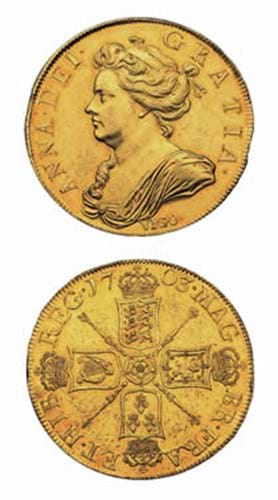
There was good reason to pray that this sale would do well. And it did.
The reason for the unexpected unease which preceded the sale - and which was confounded by the results - was that there seemed to be too much of the same thing.
Mr King had attempted to collect an example of every English five-guinea piece. This has never been achieved previously and the catalogue is most instructive on this matter. The preface to the catalogue, an example of staggering application, consists of a detailed analysis of just how rare is each five-guinea piece.
This is worth a précis. There are 49 dates involved spread over 72 main varieties. The most complete series ever formed was sold at Sotheby's as long ago as 1904, with 43 of the possible dates. The Lady Duveen collection, sold at Glendinings in 1964, also had 43 of the dates and 60 of the 72 varieties.
These dry numbers are enough to demonstrate that this sale was an historic if homogeneous occasion. Hence the speculation; was this sale offering too many of the same thing to be absorbed by the market and was there the capital available for a narrow speciality?
To complete the picture it is worth noting that just over 3000 (3031) of these coins have been on the market since 1960. True there will have been more offerings but Spink's analysis has gone to great pains to try to avoid counting the same specimen twice by comparing illustrations in catalogues. I wilt at the thought of the application required.
In this recent sale there were 60 five-guinea pieces and the specialised catalogue forms a permanent record of this area. It is sometimes useful to have a general idea of rarity although it is hazardous to use this information outside a very narrow context.
What happened to this remarkable group? The market indeed could take it and there was the money available to absorb these coins. It is my observation, with about 60 people in the room, that this is a fragile market. There were two main buyers for these coins and it appears that they are fairly new to the market. Of course, we do not know what their future intentions are; they may continue to dominate the market and so act as a magnet for more new buyers. If this happens, this sale will have created a new price-hike which should be reflected in the market as a whole. We must wait and see.
Most of the coins found a new owner at prices which hovered around the top estimates; for the most part in the £4000-8000 bracket. The sale went very well indeed but in a slightly different market climate it could have been very different.
It is a tribute to the cataloguer and estimator that the sale was such a triumph. In addition, this catalogue is particularly useful in that many of the coins had old provenances which demonstrates just what a fine investment they have been.
Battle prize
The highest price of the day was the £130,000 paid for the Queen Anne 1703 five guineas struck from gold taken as a prize at the sea battle of Vigo Bay, when a British/Dutch fleet thrashed a Spanish/French treasure fleet on October 12, 1702. It is estimated that some 15 or 20 at most have survived. Spink's catalogue of the recent sale records five examples offered for sale since 1960. The estimate here was a sensible £40,000-50,000.
With the catalogue of this coin's interesting history, I can add the prices realised. It was sold at Sotheby's in 1974 for £26,000 and again at Spink in 1989 for £39,000.
There is a bit more price-history to this coin. Another example was sold at Glendinings in 1992 for £40,000 and the same price was paid at Dix Noonan Webb in 1998 for an example which could be either or neither of these.
Likewise Spink had one in 1993 which did not sell at £40,000 and one was offered at Glendinings in 2001 which also failed to find a new home.
Of the 217 lots offered, only 15 failed to find buyers (6.9 per cent), which is a very good failure rate, particularly for such material. The hammer total for the day was £1.42m.




